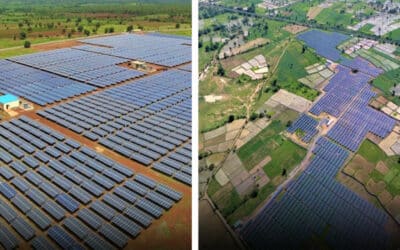Navigating a New Era of Risks
The global economic outlook continues to remain challenging, particularly given the effects of higher inflation, as a result of supply side imbalances following covid-19 and subsequently the war in Ukraine. Energy and food prices remain major contributors to this surge with prospects of further rises in interest rates going into next year. With recessionary warning signs flashing, a flight to safety has strengthened the US dollar, with the index (DXY) peaking above 13% before softening to 4.6% YTD. Despite emerging markets facing higher import costs and stronger inflationary pressures as a result, including the prospects of depleted currency reserves, economic growth forecasts remain positive for this year, albeit at more moderated levels.
Many emerging markets have been tightening monetary policy, however the subsequent impacts on growth vary depending on the country profile. Currencies that are backed by economies with high value commodity exports such as oil and copper can offset against impacts of higher import prices for food and energy. Countries such as Brazil and Indonesia are benefiting from improved current accounts as a result of strong commodity exports, whilst energy importers such as India, South Korea and Philippines are more vulnerable. Several EMs have pivoted to discounted Russian oil following western sanctions, in a trend of financially stressed countries looking to reduce import costs. Sri Lanka, which defaulted on its debts earlier this year has struggled with energy supply shortages and has begun importing large quantities of oil from Russia. Other countries such as India and Pakistan have also become buyers. Bangladesh recently agreed to a $4.5bn IMF support loan to help prevent economic instability, becoming the third country this year after Pakistan and Sri Lanka to obtain such funding. Following below-target economic growth year-to-date, as well as widespread anti-lockdown protests, China recently announced a wide-ranging relaxation of zero-covid restrictions including home quarantining and reduced testing for public places. China has faced difficult export trading conditions as other countries face recession, as well as a fragile domestic property sector. The road ahead could still be bumpy as the country reopens.
Markets continue to remain volatile as they adjust to a new era of more restrictive monetary policy. Whilst global inflation is predicted to moderate next year, it is likely to remain elevated relative to targets in many economies, not least in the US and Europe in the short term. For EMs, many central banks have already been raising interest rates. Brazil and Mexico have been moving broadly in tandem with the US Fed, leading to forecasts that the LatAm tightening cycle will end earlier than in other EM regions.
At the beginning of 2023, there are several supportive factors including the prospects of covid-19 shifting towards endemic stage, several EMs already active in their interest rate tightening, USD depreciation providing a positive tailwind for EM currencies and markets, and falling commodity prices across oil, industrial metals, and agriculture which makes a significant portion of consumer spend in EMs. Global growth expectations for emerging markets remain higher than advanced economies (3.6% vs. 2.5% in 2022) and (3.9% to 1.4% in 2023) which is encouraging for Sarona’s investment universe. Nevertheless, we remain particularly cautious of the ongoing war in Ukraine and the potential for more sustained supply chain disruptions, the second order effects of inflation, particularly in South East Asia where higher input costs are translating into demands for increased pay and rents, but also the risks of escalating social unrest on the global economy.
The Climate Opportunity for 2030
According to new research commissioned by the governments of Egypt and the UK, investments of $1 trillion annually by 2025 (4.1% of GDP vs. 2.2% in 2019), and $2.4 trillion p.a. from 2030 (6.5% of GDP), is required in emerging markets and developing countries (ex. China) to cut emissions, boost resilience and deal with loss and damage caused by climate change impacts.
At the recent COP27 in Egypt, there were growing calls for greater cohesion between providers of capital to achieve these objectives, by taking advantage of powerful multipliers that can emerge from complementary strengths from different sources of finance. A new roadmap highlights the significant scope for public policy and governments to foster investment, as well as contributions from the private sector, multilateral developments banks, international finance institutions, and concessional finance. Whilst around half the funding required can come from domestic sources, the remaining half needs to be raised externally. Given that most growth of energy infrastructure and consumption over the next decade will be from emerging markets, it is in developed countries’ self-interest to help achieve the external financing targets to reduce dependences on fossil fuels and emissions. In the current climate, particularly given the pressure on public budgets in many countries, the role of multilateral development banks and blended finance solutions in general, will be critical as a source of external finance and bringing down cost of capital for private investors. However, financing alone won’t be enough as it needs to be coupled with the right instruments, capacity building, and policies to accelerate and scale climate impact investments.
The establishment of a Loss and Damage Fund was a key highlight of COP27 and aims to provide financial assistance to nations most vulnerable and impacted by the effects of climate change. Whilst many of the details are yet to be negotiated, it will support for losses arising from droughts, floods, rising seas and other disasters which is particularly welcome after the recent widespread flooding across Pakistan.
SMEs are an important market segment and have been largely underserved by climate action initiatives as most climate finance mobilized to date is targeted at large-scale projects or companies in sectors like energy, and infrastructure. At Sarona, our EMIIF programme is looking to mobilise capital in South East Asia by partnering with VC and PE funds investing in SMEs in the renewable energy and electrical vehicle sectors, amongst others. While our SGGM programme carries a global emerging markets investment approach; some of the current fund and direct company investments include SMEs focusing on relevant sub-sectors like waste management, water saving and climate-smart agriculture / food production.
References:
- Building in a new era of risks. Emerging Markets Q4 2022 Outlook. Source: Triodos, September 2022
- China’s low-growth era. Source: Financial Times, October 2022
- China retreats from sweeping zero-Covid policies as economic toll mounts. Source: Financial Times, December 2022
- COP27 Reaches Breakthrough Agreement on New “Loss and Damage” Fund for Vulnerable Countries. Source: United Nations Climate Change, November 2022
- COP27 report calls for international investments of $1 trillion annually by 2030 in climate action in developing countries. Source: The London School of Economics and Political Science, November 2022
- Crisis-hit Sri Lanka snaps up cheap Russian oil. Source: Financial Times, October 2022
- EM Equity in 2023: Will the longest bear market in history continue? Source: Wellington, November 2022
- Global Economy Headed Into Recession. Source: Forbes, September 2022
- Global Monetary Policy Tracker. Source: Council on Foreign Relations, October 2022
- Grim Outlook for 2023 – Rolling Recessions and Central Bank Rate Hikes. Source: Citi, November 2022
- IMF agrees $4.5 billion Bangladesh support programme. Source: Reuters, November 2022
- Outlook on Emerging Markets. Source: Lazard Asset Management, October 2022
- SEA Fund II Quarterly Report: Source: Actis, September 2022
- 2023 Global Outlook. Source: TD Securities, November 2022
- 2023 Outlook: ready for reset. Navigating Rates. Source: Allianz, November 2022


